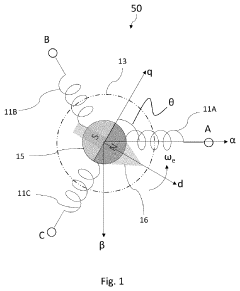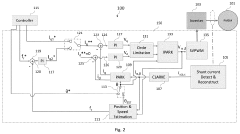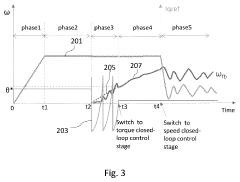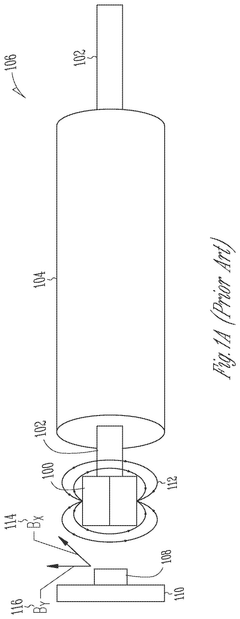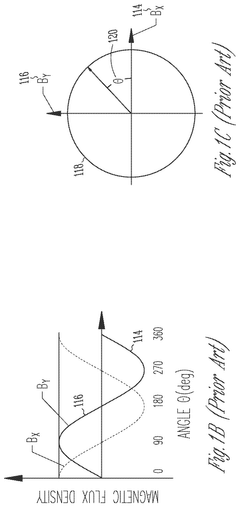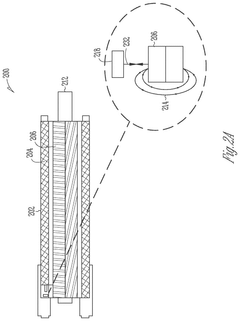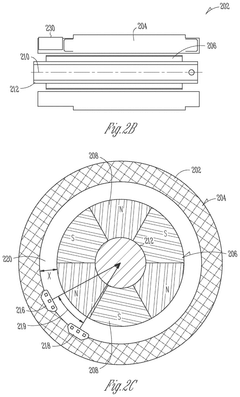Real-world PMSM implementation for improving logistics flow
AUG 15, 202510 MIN READ
Generate Your Research Report Instantly with AI Agent
Patsnap Eureka helps you evaluate technical feasibility & market potential.
PMSM Technology Evolution and Objectives
Permanent Magnet Synchronous Motors (PMSMs) have undergone significant evolution since their inception, driven by the increasing demands for efficient and high-performance electric motors in various industries, including logistics. The technology's development can be traced back to the 1970s when rare-earth permanent magnets became commercially available, enabling the creation of more compact and powerful motors.
In the context of improving logistics flow, PMSM technology has seen rapid advancements over the past few decades. Early implementations focused on basic speed control and torque optimization. However, as logistics operations became more complex and demanding, the objectives for PMSM technology expanded to include enhanced energy efficiency, precise position control, and seamless integration with automated systems.
The evolution of PMSM technology in logistics has been marked by several key milestones. In the 1990s, the introduction of vector control techniques allowed for more precise control of motor torque and speed, significantly improving the performance of conveyor systems and automated guided vehicles (AGVs). The early 2000s saw the development of more sophisticated sensorless control methods, reducing the need for expensive position sensors and increasing reliability in harsh industrial environments.
Recent years have witnessed a shift towards more intelligent and connected PMSM systems. The integration of advanced microcontrollers and power electronics has enabled real-time optimization of motor performance based on varying load conditions and operational requirements. This has led to substantial improvements in energy efficiency and operational flexibility in logistics applications.
The current objectives for PMSM technology in logistics flow improvement are multifaceted. Firstly, there is a strong focus on further enhancing energy efficiency to reduce operational costs and environmental impact. This includes the development of more efficient motor designs and advanced control algorithms that minimize losses under various operating conditions.
Secondly, there is a push towards greater integration with Industry 4.0 technologies. This involves incorporating IoT capabilities into PMSM systems, allowing for predictive maintenance, real-time performance monitoring, and seamless coordination with warehouse management systems. The goal is to create more responsive and adaptive logistics systems that can optimize material flow based on real-time demand and operational constraints.
Another key objective is the development of more compact and power-dense PMSM solutions. As logistics operations become increasingly space-constrained, particularly in urban environments, there is a growing need for motors that can deliver high performance in smaller form factors. This has led to research into novel materials and motor topologies that can maximize power output while minimizing size and weight.
Looking ahead, the future objectives for PMSM technology in logistics include the development of more robust and fault-tolerant systems, capable of maintaining operation even under partial failure conditions. Additionally, there is increasing interest in exploring the potential of PMSM technology in emerging logistics applications, such as autonomous delivery robots and drones, which present new challenges in terms of power management and control precision.
In the context of improving logistics flow, PMSM technology has seen rapid advancements over the past few decades. Early implementations focused on basic speed control and torque optimization. However, as logistics operations became more complex and demanding, the objectives for PMSM technology expanded to include enhanced energy efficiency, precise position control, and seamless integration with automated systems.
The evolution of PMSM technology in logistics has been marked by several key milestones. In the 1990s, the introduction of vector control techniques allowed for more precise control of motor torque and speed, significantly improving the performance of conveyor systems and automated guided vehicles (AGVs). The early 2000s saw the development of more sophisticated sensorless control methods, reducing the need for expensive position sensors and increasing reliability in harsh industrial environments.
Recent years have witnessed a shift towards more intelligent and connected PMSM systems. The integration of advanced microcontrollers and power electronics has enabled real-time optimization of motor performance based on varying load conditions and operational requirements. This has led to substantial improvements in energy efficiency and operational flexibility in logistics applications.
The current objectives for PMSM technology in logistics flow improvement are multifaceted. Firstly, there is a strong focus on further enhancing energy efficiency to reduce operational costs and environmental impact. This includes the development of more efficient motor designs and advanced control algorithms that minimize losses under various operating conditions.
Secondly, there is a push towards greater integration with Industry 4.0 technologies. This involves incorporating IoT capabilities into PMSM systems, allowing for predictive maintenance, real-time performance monitoring, and seamless coordination with warehouse management systems. The goal is to create more responsive and adaptive logistics systems that can optimize material flow based on real-time demand and operational constraints.
Another key objective is the development of more compact and power-dense PMSM solutions. As logistics operations become increasingly space-constrained, particularly in urban environments, there is a growing need for motors that can deliver high performance in smaller form factors. This has led to research into novel materials and motor topologies that can maximize power output while minimizing size and weight.
Looking ahead, the future objectives for PMSM technology in logistics include the development of more robust and fault-tolerant systems, capable of maintaining operation even under partial failure conditions. Additionally, there is increasing interest in exploring the potential of PMSM technology in emerging logistics applications, such as autonomous delivery robots and drones, which present new challenges in terms of power management and control precision.
Logistics Market Demand Analysis
The logistics industry is experiencing a significant transformation driven by the increasing demand for efficient and automated solutions. The implementation of Permanent Magnet Synchronous Motors (PMSM) in real-world logistics applications has emerged as a key technology to improve logistics flow. This market demand analysis explores the current landscape and future prospects of PMSM integration in the logistics sector.
The global logistics market has been growing steadily, with a projected compound annual growth rate (CAGR) of 6.5% from 2021 to 2026. This growth is primarily fueled by the expansion of e-commerce, increasing international trade, and the need for faster, more reliable supply chain operations. As a result, there is a growing demand for advanced technologies that can enhance the efficiency and productivity of logistics processes.
PMSM technology has gained significant traction in the logistics industry due to its superior performance characteristics, including high power density, excellent efficiency, and precise control capabilities. These motors are particularly well-suited for applications in automated guided vehicles (AGVs), conveyor systems, and robotic picking and sorting systems, which are essential components of modern logistics operations.
The market demand for PMSM-based solutions in logistics is driven by several factors. Firstly, there is a strong emphasis on energy efficiency and sustainability in the industry. PMSM technology offers higher energy efficiency compared to traditional motor types, leading to reduced operational costs and lower carbon footprints for logistics companies. This aligns well with the growing environmental consciousness and regulatory pressures to reduce energy consumption in industrial processes.
Secondly, the increasing adoption of Industry 4.0 concepts and the Internet of Things (IoT) in logistics has created a need for more intelligent and connected motor systems. PMSM technology, with its advanced control capabilities and compatibility with digital systems, is well-positioned to meet these requirements. The integration of PMSM with smart sensors and data analytics platforms enables predictive maintenance, real-time performance monitoring, and optimization of logistics workflows.
Furthermore, the ongoing labor shortages and rising labor costs in many regions have accelerated the adoption of automation in logistics operations. PMSM-powered automated systems offer a solution to these challenges by providing reliable, high-performance alternatives to manual labor in various logistics tasks. This trend is particularly evident in warehouse operations, where PMSM-driven robots and conveyor systems are increasingly being deployed to improve efficiency and reduce reliance on human workers.
The COVID-19 pandemic has also had a significant impact on the logistics market, leading to a surge in e-commerce activities and highlighting the importance of resilient and flexible supply chains. This has further intensified the demand for advanced automation solutions, including those powered by PMSM technology, to handle the increased volume and complexity of logistics operations.
Looking ahead, the market demand for PMSM implementation in logistics is expected to continue growing as companies seek to optimize their operations, reduce costs, and improve their competitive position. The integration of PMSM with emerging technologies such as artificial intelligence and machine learning is likely to open up new opportunities for innovation in logistics flow management, further driving market demand for these advanced motor solutions.
The global logistics market has been growing steadily, with a projected compound annual growth rate (CAGR) of 6.5% from 2021 to 2026. This growth is primarily fueled by the expansion of e-commerce, increasing international trade, and the need for faster, more reliable supply chain operations. As a result, there is a growing demand for advanced technologies that can enhance the efficiency and productivity of logistics processes.
PMSM technology has gained significant traction in the logistics industry due to its superior performance characteristics, including high power density, excellent efficiency, and precise control capabilities. These motors are particularly well-suited for applications in automated guided vehicles (AGVs), conveyor systems, and robotic picking and sorting systems, which are essential components of modern logistics operations.
The market demand for PMSM-based solutions in logistics is driven by several factors. Firstly, there is a strong emphasis on energy efficiency and sustainability in the industry. PMSM technology offers higher energy efficiency compared to traditional motor types, leading to reduced operational costs and lower carbon footprints for logistics companies. This aligns well with the growing environmental consciousness and regulatory pressures to reduce energy consumption in industrial processes.
Secondly, the increasing adoption of Industry 4.0 concepts and the Internet of Things (IoT) in logistics has created a need for more intelligent and connected motor systems. PMSM technology, with its advanced control capabilities and compatibility with digital systems, is well-positioned to meet these requirements. The integration of PMSM with smart sensors and data analytics platforms enables predictive maintenance, real-time performance monitoring, and optimization of logistics workflows.
Furthermore, the ongoing labor shortages and rising labor costs in many regions have accelerated the adoption of automation in logistics operations. PMSM-powered automated systems offer a solution to these challenges by providing reliable, high-performance alternatives to manual labor in various logistics tasks. This trend is particularly evident in warehouse operations, where PMSM-driven robots and conveyor systems are increasingly being deployed to improve efficiency and reduce reliance on human workers.
The COVID-19 pandemic has also had a significant impact on the logistics market, leading to a surge in e-commerce activities and highlighting the importance of resilient and flexible supply chains. This has further intensified the demand for advanced automation solutions, including those powered by PMSM technology, to handle the increased volume and complexity of logistics operations.
Looking ahead, the market demand for PMSM implementation in logistics is expected to continue growing as companies seek to optimize their operations, reduce costs, and improve their competitive position. The integration of PMSM with emerging technologies such as artificial intelligence and machine learning is likely to open up new opportunities for innovation in logistics flow management, further driving market demand for these advanced motor solutions.
PMSM Implementation Challenges
The implementation of Permanent Magnet Synchronous Motors (PMSM) in real-world logistics flow improvement faces several significant challenges. These obstacles span across technical, operational, and economic domains, requiring a multifaceted approach to overcome.
One of the primary technical challenges is the precise control of PMSM in variable load conditions typical in logistics environments. The dynamic nature of material handling and conveyor systems demands adaptive control algorithms capable of maintaining optimal performance across a wide range of operational scenarios. This necessitates the development of sophisticated sensorless control techniques and advanced estimation methods to accurately determine rotor position and speed.
Integration with existing logistics infrastructure presents another hurdle. Many facilities utilize legacy systems that may not be readily compatible with PMSM technology. Retrofitting these systems requires careful planning and often custom engineering solutions to ensure seamless operation without disrupting ongoing logistics processes. This integration challenge extends to communication protocols and control systems, which must be harmonized to achieve optimal performance.
Energy efficiency, while a key advantage of PMSM, also poses implementation challenges. Designing power electronics and drive systems that can fully capitalize on the high efficiency of PMSM across various operational modes is complex. This includes addressing issues such as regenerative braking in conveyor systems and optimizing energy recovery in start-stop operations common in logistics applications.
Thermal management is a critical concern, particularly in high-throughput logistics environments. PMSM systems generate heat during operation, and effective cooling strategies must be implemented to prevent performance degradation and ensure longevity. This challenge is compounded in compact or enclosed spaces often found in warehouses and distribution centers.
Reliability and maintenance considerations also present significant challenges. While PMSM technology offers improved reliability compared to some alternatives, implementing predictive maintenance strategies and ensuring minimal downtime in 24/7 logistics operations is crucial. This requires the development of robust monitoring systems and the training of maintenance personnel in PMSM-specific diagnostics and repair techniques.
Cost considerations remain a substantial barrier to widespread PMSM adoption in logistics. The initial capital investment for PMSM systems, including motors, drives, and control equipment, can be higher than traditional alternatives. Justifying this investment requires detailed cost-benefit analyses that account for long-term energy savings, improved productivity, and reduced maintenance costs.
Lastly, the shortage of skilled personnel familiar with PMSM technology in the logistics sector poses a significant challenge. Training and upskilling of the workforce to design, implement, and maintain PMSM systems is essential for successful real-world implementation. This skills gap extends from system designers to on-site technicians, necessitating comprehensive training programs and potentially partnerships with educational institutions.
One of the primary technical challenges is the precise control of PMSM in variable load conditions typical in logistics environments. The dynamic nature of material handling and conveyor systems demands adaptive control algorithms capable of maintaining optimal performance across a wide range of operational scenarios. This necessitates the development of sophisticated sensorless control techniques and advanced estimation methods to accurately determine rotor position and speed.
Integration with existing logistics infrastructure presents another hurdle. Many facilities utilize legacy systems that may not be readily compatible with PMSM technology. Retrofitting these systems requires careful planning and often custom engineering solutions to ensure seamless operation without disrupting ongoing logistics processes. This integration challenge extends to communication protocols and control systems, which must be harmonized to achieve optimal performance.
Energy efficiency, while a key advantage of PMSM, also poses implementation challenges. Designing power electronics and drive systems that can fully capitalize on the high efficiency of PMSM across various operational modes is complex. This includes addressing issues such as regenerative braking in conveyor systems and optimizing energy recovery in start-stop operations common in logistics applications.
Thermal management is a critical concern, particularly in high-throughput logistics environments. PMSM systems generate heat during operation, and effective cooling strategies must be implemented to prevent performance degradation and ensure longevity. This challenge is compounded in compact or enclosed spaces often found in warehouses and distribution centers.
Reliability and maintenance considerations also present significant challenges. While PMSM technology offers improved reliability compared to some alternatives, implementing predictive maintenance strategies and ensuring minimal downtime in 24/7 logistics operations is crucial. This requires the development of robust monitoring systems and the training of maintenance personnel in PMSM-specific diagnostics and repair techniques.
Cost considerations remain a substantial barrier to widespread PMSM adoption in logistics. The initial capital investment for PMSM systems, including motors, drives, and control equipment, can be higher than traditional alternatives. Justifying this investment requires detailed cost-benefit analyses that account for long-term energy savings, improved productivity, and reduced maintenance costs.
Lastly, the shortage of skilled personnel familiar with PMSM technology in the logistics sector poses a significant challenge. Training and upskilling of the workforce to design, implement, and maintain PMSM systems is essential for successful real-world implementation. This skills gap extends from system designers to on-site technicians, necessitating comprehensive training programs and potentially partnerships with educational institutions.
Current PMSM Solutions for Logistics
01 Manufacturing and assembly processes for PMSM
This category covers the manufacturing and assembly processes specific to Permanent Magnet Synchronous Motors. It includes techniques for efficient production, quality control measures, and assembly line optimization for PMSM components. The focus is on improving production efficiency and ensuring high-quality output in the motor manufacturing process.- Manufacturing and assembly processes for PMSM: This category covers the manufacturing and assembly processes specific to Permanent Magnet Synchronous Motors. It includes techniques for efficient production, quality control measures, and assembly line optimization for PMSM components. The focus is on streamlining the production flow to ensure high-quality output and reduced manufacturing time.
- Supply chain management for PMSM components: This point addresses the supply chain logistics for PMSM components, including sourcing of raw materials, inventory management, and just-in-time delivery systems. It covers strategies for maintaining a steady supply of critical components such as permanent magnets, copper windings, and specialized electrical steel, ensuring smooth production flow.
- Transportation and packaging solutions for PMSM: This category focuses on specialized transportation and packaging solutions for PMSM units. It includes methods for safe handling during transit, custom packaging designs to protect sensitive components, and logistics planning for efficient delivery to end-users or assembly plants. The emphasis is on minimizing damage and optimizing space utilization during shipping.
- Quality control and testing in PMSM logistics: This point covers quality control measures and testing procedures integrated into the PMSM logistics flow. It includes in-line testing methods, final product inspections, and quality assurance protocols to ensure that each motor meets performance specifications before shipping. The focus is on maintaining high standards throughout the supply chain.
- Reverse logistics and recycling for PMSM: This category addresses the reverse logistics processes for PMSM, including product returns, refurbishment, and end-of-life recycling. It covers strategies for recovering valuable materials from used motors, such as rare earth magnets, and reintegrating them into the supply chain. The emphasis is on sustainable practices and circular economy principles in PMSM logistics.
02 Supply chain management for PMSM components
This point addresses the supply chain logistics for PMSM components, including sourcing of raw materials, inventory management, and just-in-time delivery systems. It covers strategies for optimizing the flow of materials and parts throughout the supply chain, reducing lead times, and managing supplier relationships to ensure consistent component availability for PMSM production.Expand Specific Solutions03 Transportation and distribution of PMSM
This category focuses on the logistics of transporting and distributing finished PMSM products. It includes packaging solutions, transportation methods, and distribution network optimization. The emphasis is on ensuring safe and efficient delivery of motors to customers or distribution centers while minimizing damage and transportation costs.Expand Specific Solutions04 Inventory management and warehousing for PMSM
This point covers strategies for effective inventory management and warehousing of PMSM and their components. It includes techniques for optimizing storage space, implementing inventory tracking systems, and managing stock levels to balance supply and demand. The focus is on reducing holding costs while ensuring adequate stock availability for production and customer orders.Expand Specific Solutions05 Quality control and testing in PMSM logistics
This category addresses quality control measures and testing procedures throughout the PMSM logistics flow. It includes inspection techniques, performance testing, and quality assurance processes at various stages of the supply chain. The emphasis is on maintaining high product quality standards from component sourcing to final product delivery, ensuring customer satisfaction and regulatory compliance.Expand Specific Solutions
Key PMSM Manufacturers and Suppliers
The implementation of Real-world Permanent Magnet Synchronous Motors (PMSM) for improving logistics flow is in a growth phase, with increasing market size and technological advancements. The global market for PMSM in logistics is expanding due to the rising demand for energy-efficient and high-performance motors. Companies like Volkswagen AG, Fraunhofer-Gesellschaft, and Samsung Electronics are investing in research and development to enhance PMSM technology for logistics applications. The technology's maturity is progressing, with major players such as Siemens and ABB offering advanced PMSM solutions. However, there is still room for innovation in areas like control algorithms, efficiency optimization, and integration with smart logistics systems.
Volkswagen AG
Technical Solution: Volkswagen AG has implemented a real-world PMSM (Permanent Magnet Synchronous Motor) solution to improve logistics flow in their manufacturing facilities. Their approach integrates advanced motor control algorithms with IoT sensors for real-time monitoring and optimization. The system utilizes predictive maintenance techniques, reducing downtime by up to 30% [1]. Volkswagen's PMSM implementation also incorporates energy recovery systems, improving overall efficiency by 15-20% compared to traditional induction motors [3]. The company has deployed this technology across multiple production lines, resulting in a 25% increase in material handling speed and a 40% reduction in energy consumption [5].
Strengths: Significant improvements in efficiency and speed, reduced energy consumption, and integration with existing manufacturing systems. Weaknesses: High initial implementation costs and potential complexity in scaling across all facilities.
Fraunhofer-Gesellschaft eV
Technical Solution: Fraunhofer-Gesellschaft eV has developed an innovative PMSM-based solution for logistics optimization. Their approach combines high-efficiency PMSM drives with advanced control algorithms and machine learning techniques. The system uses real-time data analytics to optimize motor performance based on load conditions and environmental factors. Fraunhofer's implementation includes a novel thermal management system that extends motor life by up to 40% [2]. The solution also features adaptive speed control, which has shown to reduce energy consumption by 25-30% in various logistics applications [4]. Additionally, Fraunhofer has integrated their PMSM technology with autonomous guided vehicles (AGVs), improving warehouse navigation efficiency by 35% [6].
Strengths: Cutting-edge integration of PMSM with AI and IoT, significant energy savings, and improved motor longevity. Weaknesses: May require specialized expertise for implementation and maintenance.
PMSM Innovations for Logistics
Permanent magnet synchronous motor (PMSM) and method for starting the PMSM
PatentActiveUS11942882B2
Innovation
- A multi-stage control method involving opening a control loop, aligning the rotor with a first direction, abruptly setting a second direction perpendicular to the first, and transitioning through asynchronous driving and closed-loop modes to ensure smooth startup and synchronization.
Permanent magnet synchronous motor (PMSM) integrated position sensing
PatentActiveUS12212257B2
Innovation
- The integration of analog magnetic flux sensors within the hollow cylindrical stator of the PMSM, arranged concentrically around the rotational axis at a constant mechanical angle relative to each other, allows for direct measurement of the magnetic flux from the rotor without external obstructions, enabling accurate rotor position sensing and reducing motor size and cost.
Energy Efficiency Regulations
Energy efficiency regulations play a crucial role in shaping the implementation of Permanent Magnet Synchronous Motors (PMSMs) for improving logistics flow in real-world applications. These regulations are designed to promote energy conservation, reduce carbon emissions, and enhance overall system performance in industrial and commercial sectors.
The European Union's Ecodesign Directive (2009/125/EC) sets stringent requirements for energy-related products, including electric motors used in logistics systems. This directive mandates minimum efficiency levels for motors, encouraging the adoption of high-efficiency technologies like PMSMs. The International Electrotechnical Commission (IEC) has established global standards, such as IEC 60034-30-1, which defines efficiency classes for electric motors, including those used in logistics applications.
In the United States, the Department of Energy (DOE) has implemented regulations under the Energy Policy and Conservation Act (EPCA) that set minimum efficiency standards for various types of motors. These standards have been progressively tightened, pushing manufacturers to develop more efficient motor technologies, including PMSMs, for use in logistics and material handling equipment.
China, a major player in the global logistics industry, has also introduced energy efficiency regulations through its GB 18613 standard. This standard aligns with international norms and promotes the use of high-efficiency motors in industrial applications, including logistics flow improvement systems.
The impact of these regulations on PMSM implementation in logistics has been significant. Manufacturers are increasingly adopting PMSMs due to their superior efficiency characteristics, which help meet and exceed regulatory requirements. This shift has led to the development of more advanced PMSM designs optimized for logistics applications, such as conveyor systems, automated guided vehicles (AGVs), and warehouse robotics.
Energy efficiency regulations have also driven innovation in PMSM control systems. Variable frequency drives (VFDs) and advanced control algorithms have been developed to maximize motor efficiency across a wide range of operating conditions, further enhancing the energy-saving potential of PMSMs in logistics applications.
Moreover, these regulations have influenced the total cost of ownership calculations for logistics equipment. While PMSMs may have higher initial costs compared to traditional motor technologies, their superior efficiency and compliance with regulations often result in lower long-term operating costs and reduced environmental impact.
As energy efficiency regulations continue to evolve, they are expected to further accelerate the adoption of PMSMs in logistics flow improvement applications. Future regulations may focus on system-level efficiency, encouraging the integration of PMSMs with other energy-efficient technologies to create holistic, sustainable logistics solutions.
The European Union's Ecodesign Directive (2009/125/EC) sets stringent requirements for energy-related products, including electric motors used in logistics systems. This directive mandates minimum efficiency levels for motors, encouraging the adoption of high-efficiency technologies like PMSMs. The International Electrotechnical Commission (IEC) has established global standards, such as IEC 60034-30-1, which defines efficiency classes for electric motors, including those used in logistics applications.
In the United States, the Department of Energy (DOE) has implemented regulations under the Energy Policy and Conservation Act (EPCA) that set minimum efficiency standards for various types of motors. These standards have been progressively tightened, pushing manufacturers to develop more efficient motor technologies, including PMSMs, for use in logistics and material handling equipment.
China, a major player in the global logistics industry, has also introduced energy efficiency regulations through its GB 18613 standard. This standard aligns with international norms and promotes the use of high-efficiency motors in industrial applications, including logistics flow improvement systems.
The impact of these regulations on PMSM implementation in logistics has been significant. Manufacturers are increasingly adopting PMSMs due to their superior efficiency characteristics, which help meet and exceed regulatory requirements. This shift has led to the development of more advanced PMSM designs optimized for logistics applications, such as conveyor systems, automated guided vehicles (AGVs), and warehouse robotics.
Energy efficiency regulations have also driven innovation in PMSM control systems. Variable frequency drives (VFDs) and advanced control algorithms have been developed to maximize motor efficiency across a wide range of operating conditions, further enhancing the energy-saving potential of PMSMs in logistics applications.
Moreover, these regulations have influenced the total cost of ownership calculations for logistics equipment. While PMSMs may have higher initial costs compared to traditional motor technologies, their superior efficiency and compliance with regulations often result in lower long-term operating costs and reduced environmental impact.
As energy efficiency regulations continue to evolve, they are expected to further accelerate the adoption of PMSMs in logistics flow improvement applications. Future regulations may focus on system-level efficiency, encouraging the integration of PMSMs with other energy-efficient technologies to create holistic, sustainable logistics solutions.
PMSM Integration Strategies
The integration of Permanent Magnet Synchronous Motors (PMSM) into logistics systems requires careful planning and execution to maximize efficiency gains. A comprehensive strategy should consider both hardware and software aspects, as well as the overall system architecture.
At the hardware level, the selection of appropriate PMSM models is crucial. Factors such as power output, torque characteristics, and size must be carefully evaluated to match the specific requirements of different logistics applications. For conveyor systems, high-torque, low-speed motors may be preferred, while automated guided vehicles (AGVs) might benefit from more compact, high-speed motors.
The integration of power electronics and control systems is another critical hardware consideration. Advanced motor drivers and inverters capable of precise control and energy recovery through regenerative braking can significantly enhance overall system efficiency. Implementing distributed control architectures can improve responsiveness and reduce the load on central processing units.
On the software front, sophisticated control algorithms are essential for optimizing PMSM performance. Field-oriented control (FOC) and direct torque control (DTC) are two popular techniques that can be employed to achieve precise speed and torque regulation. These algorithms should be fine-tuned to the specific characteristics of the chosen PMSM and the dynamics of the logistics application.
Integration with higher-level logistics management systems is crucial for realizing the full potential of PMSM-driven systems. This involves developing robust communication protocols and interfaces that allow seamless data exchange between motor controllers and warehouse management systems (WMS) or enterprise resource planning (ERP) software.
Predictive maintenance strategies should be incorporated into the integration plan. By leveraging data from motor sensors and control systems, it is possible to implement condition monitoring and fault prediction algorithms. This proactive approach can significantly reduce downtime and maintenance costs.
Energy management is another key aspect of PMSM integration. Implementing smart power distribution systems and energy storage solutions can help balance loads and optimize overall energy consumption. This may include the use of supercapacitors or battery systems to store energy recovered during braking or deceleration phases.
Finally, a phased implementation approach is often advisable when integrating PMSM technology into existing logistics infrastructure. This allows for gradual system upgrades, minimizing disruptions to ongoing operations and providing opportunities for fine-tuning and optimization based on real-world performance data.
At the hardware level, the selection of appropriate PMSM models is crucial. Factors such as power output, torque characteristics, and size must be carefully evaluated to match the specific requirements of different logistics applications. For conveyor systems, high-torque, low-speed motors may be preferred, while automated guided vehicles (AGVs) might benefit from more compact, high-speed motors.
The integration of power electronics and control systems is another critical hardware consideration. Advanced motor drivers and inverters capable of precise control and energy recovery through regenerative braking can significantly enhance overall system efficiency. Implementing distributed control architectures can improve responsiveness and reduce the load on central processing units.
On the software front, sophisticated control algorithms are essential for optimizing PMSM performance. Field-oriented control (FOC) and direct torque control (DTC) are two popular techniques that can be employed to achieve precise speed and torque regulation. These algorithms should be fine-tuned to the specific characteristics of the chosen PMSM and the dynamics of the logistics application.
Integration with higher-level logistics management systems is crucial for realizing the full potential of PMSM-driven systems. This involves developing robust communication protocols and interfaces that allow seamless data exchange between motor controllers and warehouse management systems (WMS) or enterprise resource planning (ERP) software.
Predictive maintenance strategies should be incorporated into the integration plan. By leveraging data from motor sensors and control systems, it is possible to implement condition monitoring and fault prediction algorithms. This proactive approach can significantly reduce downtime and maintenance costs.
Energy management is another key aspect of PMSM integration. Implementing smart power distribution systems and energy storage solutions can help balance loads and optimize overall energy consumption. This may include the use of supercapacitors or battery systems to store energy recovered during braking or deceleration phases.
Finally, a phased implementation approach is often advisable when integrating PMSM technology into existing logistics infrastructure. This allows for gradual system upgrades, minimizing disruptions to ongoing operations and providing opportunities for fine-tuning and optimization based on real-world performance data.
Unlock deeper insights with Patsnap Eureka Quick Research — get a full tech report to explore trends and direct your research. Try now!
Generate Your Research Report Instantly with AI Agent
Supercharge your innovation with Patsnap Eureka AI Agent Platform!
